Owning chickens can be a rewarding experience for any homesteader. You can get farm-fresh eggs and healthy meat for the whole family. But, newcomers to the world of homesteading and having livestock, in general, tend to expect an easier process than it turns out to be.
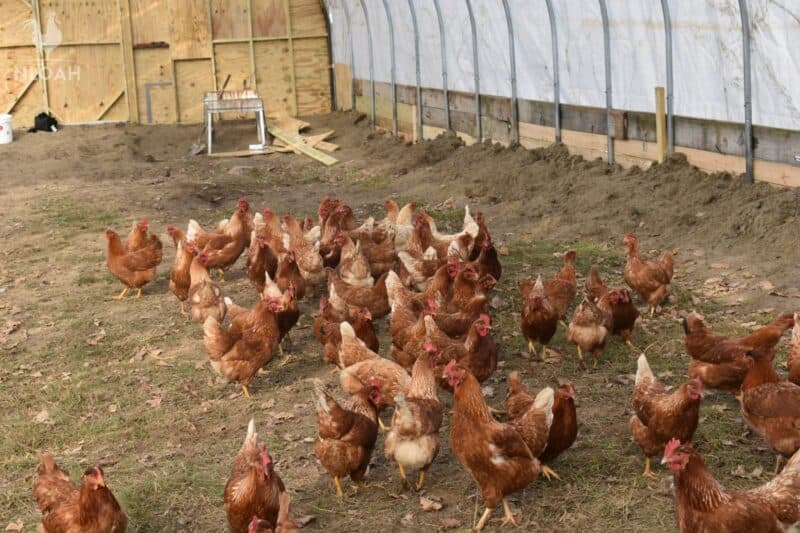
So how much does it cost to raise chickens?
The average backyard chicken keeper will pay around $60 to $100 per month to keep a flock of six birds. This includes the cost of the chicks themselves, along with feed, bedding, housing, pest control, medicine, and other supplies and equipment.
Of course, this number varies widely depending on myriad factors…
Beginner homesteaders tend to start with a garden that requires little work, but moving on to chickens can be a giant leap. This article will show you the monetary costs of raising your own flock and some of the hidden costs, like less vacation time and a daily chore list that never quits!
Monetary Costs
Of course, if we are talking about costs we have to discuss the monetary investment of owning chickens. Owning egg-laying hens and meat chickens may have different needs.
For this article, we’ll be focusing on the monetary costs of laying hens, but there is a lot of overlap for meat chickens as well.
Buying Chicks
Baby chicks aren’t free. First, you’ll have to make a trip to your local pet or farm-supply store to pick out your chicks. Or, if you want a larger selection, you can go online and pick out your preferred breed of chickens that can ship to your local post office.
Either way, you’ll pay around $3-5 for each of your day-old chicks, and be responsible for their survival from the minute you get them. They’ll probably be cold, hungry, and thirsty while chirping quite loudly.
If you want an average size flock of about 6 hens to lay a half-dozen eggs per day, you should buy 7 just in case one doesn’t make it.
Total Cost: $24 for 6, my flock of 18 cost me $90.
The Brooder
You bring them home and have to have a safe area that provides heat, water, and food. It will also need a layer of bedding (usually straw or wood shavings).
For the enclosure, you can use a dedicated brooder, or use something like a plastic tote you can pick up at your local big-box store. The heat source will typically be a heat lamp, hover brooder, or heating pad designed for baby chicks.
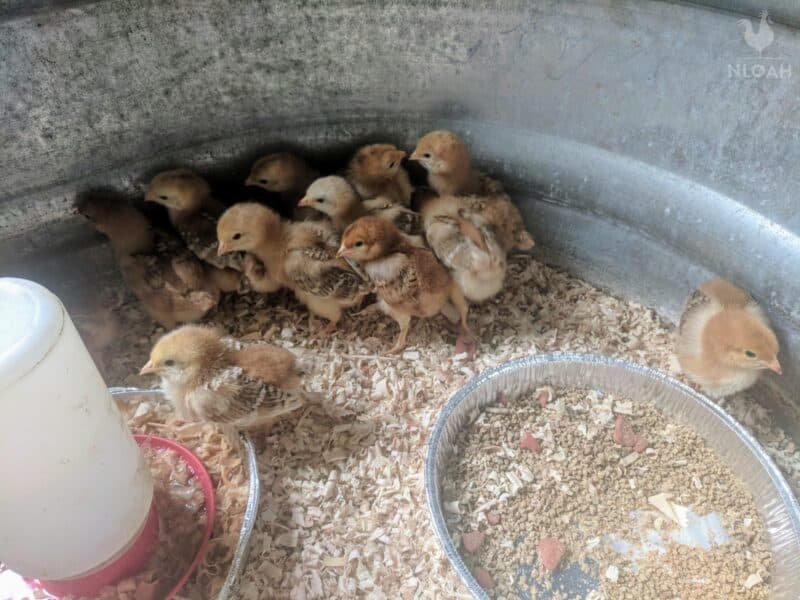
The initial feeder and waterer probably won’t last beyond the first couple of weeks as they grow rapidly and need more food and water daily. Once they are ready to move from the brooder, you have quite a few new costs to take care of.
Total Cost: $30-100, can vary widely.
The Feed
The food cost for your chickens can be as affordable as you want it to be. If you plan on free-ranging your chickens and letting them forage for as much food as possible while feeding them a standard layer feed that isn’t organic or GMO-free, you can save yourself quite a bit of money.
But, if you are like me, you have your chickens in a permanent chicken run and only feed them fresh garden scraps and organic, non-corn, non-soy, layer feed for the most nutritious eggs they can provide for my family.
Each chicken will eat around 1/4 to 1/3 lb of food each day.
Total Cost: $28/50 lbs for my high-quality feed, half or even less for lower-quality feed.
The Coop
Chickens need a place to sleep and hide from predators and the weather, which typically entails a coop. While I’ve seen 100% free-range birds that don’t even have a coop, they aren’t good egg producers at all!
The coop needs to provide around 2-4 square feet per chicken. There are free plans available online to build your own or you could buy a coop kit. Either way, the cost can be larger than you’d expect!
Total Cost: $80+
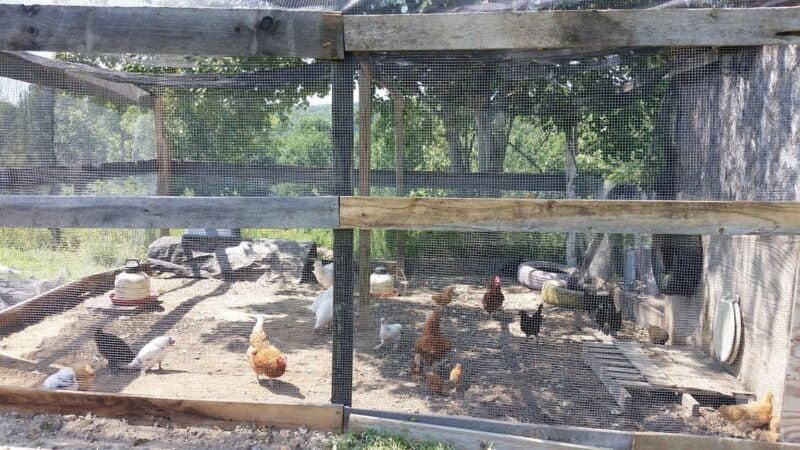
The Chicken Run
Free-range chickens may not have a run, but I like the protection and peace of mind I get with my chickens enclosed in their 400+ square feet run.
I have chain link panels and bird netting over the top, as my flock likes to try and fly out without a roof. This cost can be substantial!
Total Cost: free for free-ranging, $100+ for permanent runs
Medicine
Knock on wood, I haven’t had to deal with a sick chicken ever. But, if your flock gets sick, you may have a vet bill or need to buy specialized medicine for your flock.
Most chicken owners I know tend to cull those in the flock that get ill as a matter of efficiency.
Total Cost: varies dramatically
The Hidden Costs
Sure, you may have read up on owning chickens, and knew about the monetary costs of raising your chickens.
But, I’m about to tell you about all the hidden costs of being able to go out and harvest fresh eggs day-in and day-out!
Daily Feeding & Watering
Sure, this process doesn’t take that long. Measure out their daily ration of food, and pour it into the separate feeders every single day.
You can’t just leave as much food as possible on the run and hope they put themselves on a diet. Chickens will overeat and lower their egg production because of it!
The waterer gets dirty all the time, no matter what setup I have. This means cleaning it every day, and scrubbing it whenever I see a hint of algae growth.
Chickens drink a lot of water, especially on a hot summer day, so I may make a couple of trips to ensure they have fresh cold water. They are pickier about their water quality than you may think!
Cleaning The Coop and Run
Chicken manure is full of nutrients that can fertilize your garden and fruit trees. But, harvesting it from the chicken run and coop can be a hassle!
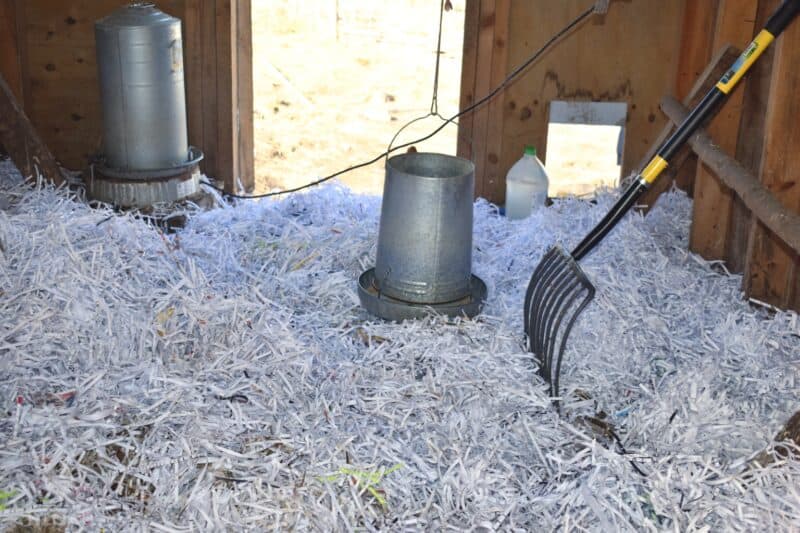
First of all, if you wait too long to do it the smell becomes atrocious. If you clean it often, the smell isn’t as bad. But, you’ll probably be cleaning your coop every week or two and your run every month or two.
I’ve learned that cleaning the coop is pointless, so I designed what I like to call my HoverCoop, which has no bottom.
The roosting bars are suspended in the air, and it is covered on all sides and the top. The chickens roost on the beams, and their manure simply falls into the run, which is where I utilize the deep litter method.
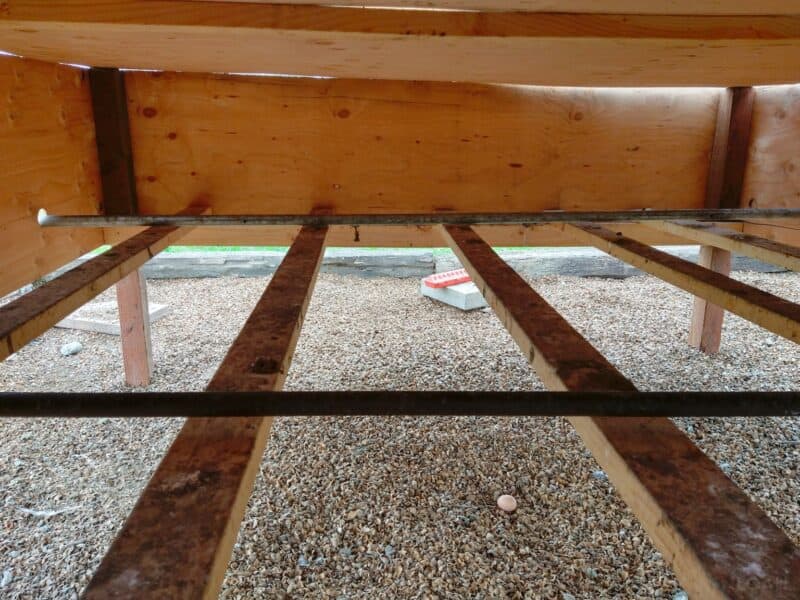
Using deep litter means less often cleaning the run and coop. But, once or twice a year, I have a day-long project of going in and removing the huge amounts of soiled deep litter that will turn into compost in a future garden.
Herding The Chickens
Don’t let your chickens out unless you have them trained like dogs! They are hard to herd around back into their pen, and even harder to catch by hand.
I’ve spent countless hours herding chickens in the past year from fence failures, and a lack of a roof over my chicken run. Now, I finally have the design that hasn’t allowed a chicken to escape for months now!
Noisy Neighbors
There is a reason that roosters are banned in many urban areas. They are loud! They don’t just crow at dawn either. They crow all day for all sorts of reasons.
You can cut down on this noise pollution by only having hens in your flock, but they can be loud as well if you have a particularly vocal group.
Some hens even have an egg-laying song where they sing a nice song each time they lay an egg (so, every day basically).
Predator Pressures
There are tons of predators that would love to turn your flock into an all-you-can-eat chicken buffet! That’s why I don’t free-range my birds and use a strong fence around my run.
Nothing is worse than having to clean up a mess of dead chicken when something inevitably gets into a weak pen or coop wrapped with chicken wire.
Few Vacation Days
Gardens are awesome because they can be set on a timer to water their plants for days on end. You can take a family vacation for a week, and not worry too much about your garden if you have it set up correctly.
This doesn’t work the same for a flock of chickens! Since we’ve established our flock on the homestead, we haven’t been away from them for more than 3 nights. Even then we had a family member come and check on them daily to ensure they had enough water and food.
The eggs also needed to be collected since they tend to get curious with eggs left around to the point of gobbling them up.
Yes, your precious hens will eat their eggs if you let them! This can cause a habit to form and all-of-a-sudden you have a flock of egg-eaters that give you nothing but empty shells strewed about.
How Much Does it Cost to Raise Chickens for Eggs?
The cost of raising chickens for eggs can vary widely depending on a number of factors, from the type of chicken you choose to the climate in which you live. However, there are some general guidelines you can follow to get an idea of the costs involved, as we described above.
If you are raising chickens for eggs, the biggest downside here is that it takes a while for pullets to get to the point-of-lay. You have to feed and house those birds from the day they hatch until they’re ready to lay. For some chicken breeds, this can take as long as six months.
Overall, you can expect to spend anywhere from $10 to $20 per chicken per year on basic care and feeding expenses. Of course, if you want to add in extras like supplemental lighting, a heat lamp, automatic chicken feeders, or heated water bowls, your costs will be even higher.
But at the end of the day, raising chickens for eggs can be a relatively inexpensive way to get fresh, healthy eggs right from your own backyard!
How Much Does it Cost to Raise Chickens for Meat?
The biggest benefit of raising meat chicken breeds is that you typically don’t have to wait as long to get a return on your investment. Some meat breeds are ready for slaughter as early as six weeks of age.
That’s much faster than what you’ll get for egg breeds, which don’t lay until they’re a few months old. Of course, you’ll be able to keep them longer – but meat tends to be worth more monetarily than eggs are.
That said, there are still costs involved.
While the cost of purchasing a live chicken may be relatively low, the cost of raising chickens for meat can quickly add up. Chickens require a constant supply of food and water, and they must be kept in a clean and safe environment.
You’ll be paying for feed – broiler feed (poultry feed for meat birds) tends to cost more than layer feed and they eat more of it – and the other expenses described above.
All of these costs can add up, making it more expensive to raise chickens for meat than many people realize. In addition, there is a significant amount of time and effort required to care for chickens.
Regular cleaning and feeding tasks can take up several hours each week, and sick or injured chickens may require even more attention.
Generally, it will cost between $1.50 and $2.50 per pound to raise your own chickens for meat.
How to Save Money Raising Chickens
Here are a few ways you can save some money when raising your backyard chickens!
Grow Your Own Chicken Feed
One of the best ways to save money while raising chickens is to grow your own chicken feed. Not only will this save you money on the cost of chicken feed, but it will also provide your chickens with a healthier diet.
You can grow your own chicken feed by planting a small garden with vegetables and fruits that chickens like to eat.
Avoid things like chicken scratch and other store-bought treats. Your chickens don’t need it, and in some cases, it can actually be harmful to their health.
Instead, if you want to give treats, just give them some kitchen scraps! Trust me, they’ll love them.
Use Herbal Supplements Instead of Chemical Medications
Another way to save money while raising chickens is to use herbal supplements instead of chemical medications. Herbal supplements are just as effective as chemical medications in preventing parasites (like lice and mites) as well as a variety of diseases, but they are much cheaper.
You can find herbal supplements at most health food stores. You can also make your own with herbs you have growing in your own garden.
Hatch Your Own Chicks
Hatching your own chicks is another great way to save money. Chicks that are purchased from a hatchery are usually quite expensive.
However, if you hatch your own chicks, you will only have to pay for the cost of the eggs (or the cost of caring for the hens who lay them) and the incubator. The latter is a one-time expense that can last several years.
Save on Vet Bills With Preventative Care
Finally, you can save on vet bills by ensuring that your chickens stay healthy through preventative care. Keep their coop clean and free of any potential hazards, feed them a balanced diet, and provide them with fresh water on a daily basis.
Put diatomaceous earth in the dust bath and grit in the feeders. Make sure your layers have access to oyster shells. Give them vitamins.
These are all simple steps, but they add up!
By taking good care of your chickens, you will reduce the chances of them getting sick and needing to see a vet.
Avoid Buying Rare Breeds
If you’re looking to save money on chickens, one of the best things you can do is avoid buying rare breeds.
While it may be tempting to purchase that fancy French Marans or silver-laced Wyandotte, there’s really no need to spend the extra money when more common breeds will do just fine.
Not only are rare breeds more expensive to purchase upfront, but they can also be more expensive to care for due to their specific housing and feeding requirements.
Reduce Chicken Coop Cost by Building Your Own
Another great way to save money on chickens is by building your own chicken coop rather than purchasing one that’s already been built. While it may take a bit more time and effort to build your own coop, the savings will be well worth it in the end.
You can find plenty of chicken coop plans online that can be customized to fit your needs and budget. Once you have all the materials you need, constructing the coop should only take a few hours.
In addition to building your own chicken coop, you can also save money by building your own perches rather than purchasing them premade. This is a relatively simple project that only requires some scrap wood and a few basic tools.
Simply cut the wood into desired lengths and attach them securely to the inside of your chicken coop so the birds have somewhere comfortable to sleep at night.
Final Words
I know this article sounds like a plea to stop you from getting your own chickens. The truth is: they are awesome to have on the homestead, and I wouldn’t have it any other way.
You just have to be ready for an adjusted lifestyle if you get a flock of layer hens or meat birds. They will take up a lot of your time if you want those farm-fresh eggs!
That said, chicken keeping doesn’t have to break the bank. Follow these tips and you’ll have fresh eggs (or meat) on the table in no time!


Milo Martinovich was born and raised in a small town in Northern California. Throughout his life, he has been involved in agriculture and now lives on a 7-acre homestead raising livestock and growing food for his family. Self-sufficiency is his ultimate goal.

As a long time chicken owner, I have some vacation suggestions: 1) get a flock block or 3. It’s not organic gmo etc. but it keeps the chickens happy and can feed them for a week or more depending on how many I get (they also work well when I have to introduce new chickens since they prefer the block to beating up on each other). 2) I usually run my hose out and leave it on a very slow stream. 3) Ceramic eggs discourage the egg stealers, but I generally do get a niece or two to check on them every few days and collect the eggs.